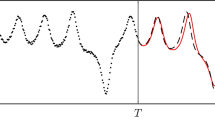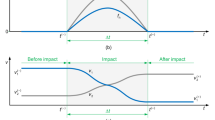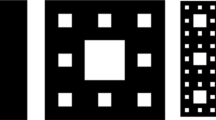Abstract
Delay systems used to model retarded actions are relevant in many fields such as optics, mechanical machining, biology or physiology. A frequently encountered situation is that the length of the delay time changes with time. In this study, we use a simple map system to investigate the influence of the fluctuating delay time on the system dynamics. For simplicity, we start from a case with the delay time taking only the value of zero or one discrete time steps, where the system dynamics reduces to one- and two-dimensional map, respectively. We study two situations, periodic or random variation of the delay. Rich dynamics including coexisting multiple attractors, strange nonchaotic attractors and on-off intermittency are observed. For a special case we can show analytically the existence of a dense set of singularities of the Lyapunov exponent. Finally we present results for higher dimensional generalizations to show the relevance of our findings to more general situations.
Similar content being viewed by others
References
K. Ikeda, H. Daido, O. Akimoto, Phys. Rev. Lett. 45, 709 (1980)
L. Glass, M.C. Mackey, From Clocks to Chaos, The Rhythms of Life (Princeton University Press, Princeton, NJ, 1988)
D.J. Amit, Modeling Brain Function: The World of Attractor Neural Networks (Cambridge University Press, New York, 1989)
J. Tlusty, A. Polacek, C. Danek, J. Spacek, Selbsterregte Schwingungen an Werkzeugmaschinen (VEB Verlag Technik, Berlin, 1962); S.A. Tobias, Machine tool vibration (Blackie, London, 1965)
R. Bellman, Adaptive control processes: A guided tour (Princeton Univ. Press, Princeton, 1961). For the recent application in the context of nonlinear dynamics see for instance K. Pyragas, Phys. Lett. A 170, 421 (1992)
S. Madruga, S. Boccaletti, M.A. Matias, Int. J. Bif. Chaos 11, 2875 (2001); W.H. Kye, M. Choi, S. Rim, M.S. Kurdoglyan, C.M. Kim, Y.J. Park, Phys. Rev. E 69, 055202(R) (2004); E.M. Shahverdiev, R.A. Nuriev, R.H. Hashimov, K.A. Shore, nlin.CD/0404050 (2004); W. Michiels, V. Van Assche, S. Niculescu, IEEE Trans. Automat. Contr. 50, 493 (2005); D.V. Senthilkumar, M. Lakshmanan, Chaos 17, 013112 (2007)
N. MacDonald, Time Lags in Biological Models, Lecture Notes in Biomathematics (Springer, Berlin, 1978), Vol. 27
T. Insperger, G. Stepan, J. Turi, Nonlinear Dyn. 47, 275 (2007)
See for example A. Fichtner, W. Just, G. Radons, J. Phys. A 37, 3385 (2004), and the references therein
G. Benettin, L. Galgani, J.M. Strelcyn, Phys. Rev. A 14, 2338 (1976); G. Benettin, L. Galgani, A. Giorgilli, J.M. Strelcyn, Meccanica 15, 9 (1980); G. Benettin, L. Galgani, A. Giorgilli, J.M. Strelcyn, Meccanica 15, 21 (1980); I. Shimada, T. Nagashima, Prog. Theor. Phys. 61, 1605 (1979)
J. Curry, Commun. Math. Phys. 68, 129 (1979)
C. Grebogi, E. Ott, S. Pelikan, J.A. Yorke, Physica D 13, 261 (1984)
J.F. Heagy, S.M. Hammel, Physica D 70, 140 (1994)
A.S. Pikovsky, U. Feudel, J. Phys. A 27, 5209 (1994)
T. Yalcinkaya, Y.C. Lai, Phys. Rev. Lett. 77, 5039 (1996)
A. Prasad, V. Mehra, R. Ramaswamy, Phys. Rev. Lett. 79, 4127 (1997)
H.L. Yang, Phys. Rev. E 63, 036208 (2001)
X.G. Wang, M. Zhan, C.H. Lai, Y.C. Lai, Phys. Rev. Lett. 92, 074102 (2004)
M.F. Barnsley, Fractals Everywhere (Academic Press Inc., New York, 1988); M.F. Barnsley, S.G. Demko, Proc. Roy. Soc. London Ser. A 399, 243 (1985)
N. Platt, E.A. Spiegel, C. Tresser, Phys. Rev. Lett. 70, 279 (1993); E. Ott, J.C. Sommerer, Phys. Lett. A 188, 39 (1994); H.L. Yang, E.J. Ding, Phys. Rev. E 54, 1361 (1996)
V.I. Oseledec, Trans. Moscow Math. Soc. 19, 197 (1968)
E. Ott, Chaos in Dynamical Systems (Cambridge University Press, New York, 1993)
See for example the chapter V of K. Knopp, Elements of the theory of functions (Dover, New York, 1952)
B. Derrida, H.J. Hilhorst, J. Phys. A: Math. Gen. 16, 2641 (1983)
Th.M. Nieuwenhuizen, J.M. Luck, J. Stat. Phys. 41, 745 (1985)
See for example the recent discussion on a high-dimensional system: E. Barreto, B.R. Hunt, C. Grebogi, J.A. Yorke, Phys. Rev. Lett. 78, 4561 (1997)
J. Wang et al., preprint
Author information
Authors and Affiliations
Corresponding author
Rights and permissions
About this article
Cite this article
Radons, G., Yang, HL., Wang, J. et al. Complex behavior of simple maps with fluctuating delay times. Eur. Phys. J. B 71, 111–119 (2009). https://doi.org/10.1140/epjb/e2009-00262-8
Received:
Revised:
Published:
Issue Date:
DOI: https://doi.org/10.1140/epjb/e2009-00262-8




